
Robert I of Normandy, also known as Robert the Magnificent and by other names, was a Norman noble of the House of Normandy who ruled as duke of Normandy from 1027 until his death in 1035. He was the son of Duke Richard II; the brother of Duke Richard III, against whom he unsuccessfully revolted; and the father of Duke William who became the first Norman king of England after winning the Battle of Hastings in 1066. During his reign, Robert quarrelled with the church—including his uncle Robert, archbishop of Rouen—and meddled in the disorder in Flanders. He finally reconciled with his uncle and the church, restoring some property and undertaking a pilgrimage to Jerusalem, during which he died.
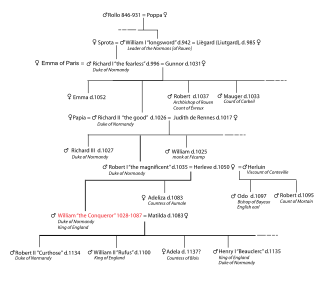
In the Middle Ages, the duke of Normandy was the ruler of the Duchy of Normandy in north-western France. The duchy arose out of a grant of land to the Viking leader Rollo by the French king Charles the Simple in 911. In 924 and again in 933, Normandy was expanded by royal grant. Rollo's male-line descendants continued to rule it until 1135, and cognatic descendants ruled it until 1204. In 1202 the French king Philip II declared Normandy a forfeited fief and by 1204 his army had conquered it. It remained a French royal province thereafter, still called the Duchy of Normandy, but only occasionally granted to a duke of the royal house as an appanage.

Richard II, called the Good, was the duke of Normandy from 996 until 1026.

Alan III of Rennes was Count of Rennes and duke of Brittany, by right of succession from 1008 to his death.
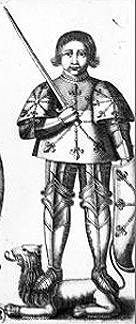
Geoffrey II, called Martel, son of Fulk the Black, was Count of Anjou from 1040 to 1060 and Count of Vendôme from 1032 to 1056. He fought battles against William VII, Duke of Aquitaine, Theobald III, Count of Blois, and William, Duke of Normandy. During his twenty-year reign Geoffrey II faced the ambitions of the Bishop of Le Mans, Gervais de Château-du-Loir, but was able to maintain his authority over the County of Maine. Martel founded the Abbey aux Dames in Saintonge and also -in collaboration with his wife Agnes- founded the Abbaye de la Trinité at Vendôme. The first mention of Geoffrey II in the Gesta Normannorum Ducum reads: "Geoffrey, count of the Angevins, nicknamed Martel, a treacherous man in every respect, frequently inflicted assaults and intolerable pressure on his neighbors."

Gesta Normannorum Ducum is a chronicle originally created by the monk William of Jumièges just before 1060. In 1070 William I had William of Jumièges extend the work to detail his rights to the throne of England. In later times, Orderic Vitalis and Robert of Torigni, extended the volumes to include history up until Henry I.

The House of Normandy was a noble family originating from the Duchy of Normandy. The House of Normandy's lineage began with the Scandinavian Rollo who founded the Duchy of Normandy in 911.
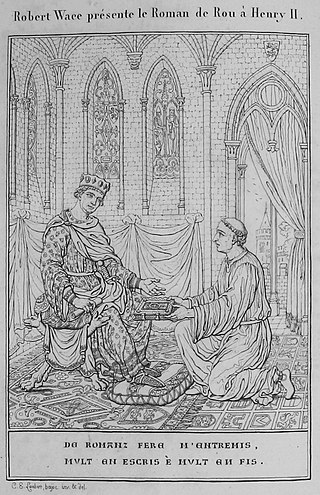
Roman de Rou is a verse chronicle by Wace in Norman covering the history of the Dukes of Normandy from the time of Rollo of Normandy to the battle of Tinchebray in 1106. It is a national epic of Normandy.
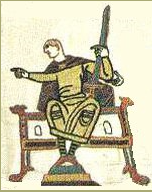
Guy I of Ponthieu was born sometime in the mid- to late 1020s and died 13 October 1100. He succeeded his brother Enguerrand II as Count of Ponthieu.

William of Talou, Count of Talou (Arques) was a powerful member of the Norman ducal family who exerted his influence during the early reign of William the Conqueror Duke of Normandy.
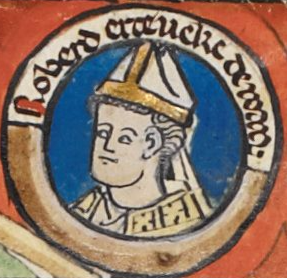
Robert II, Archbishop of Rouen, and Count of Évreux was a powerful and influential prelate, and a family member of and supporter of five dukes of Normandy.

William of Jumièges was a contemporary of the events of 1066, and one of the earliest writers on the subject of the Norman conquest of England. He is himself a shadowy figure, only known by his dedicatory letter to William the Conqueror as a monk of Jumièges. Since he also mentions that he was an eyewitness of some events from the reign of Duke Richard III (1026-7), it seems reasonable to assume that he was born some time about the year 1000. He probably entered the monastery during the first quarter of the eleventh century and received his education from Thierry de Mathonville. According to Orderic Vitalis, William's nickname was "Calculus". The meaning behind this nickname is unknown. His death, after 1070, is unrecorded. He was a Norman writing from a Norman point of view. Although only a monk with evidently no military training, he wrote with pride in the accomplishments of his people.
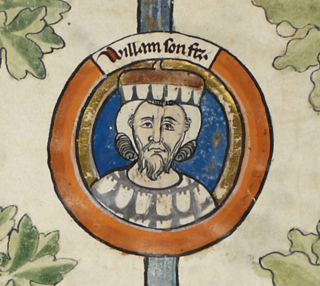
William Longsword was the second ruler of Normandy, from 927 until his assassination in 942.
Anslech or Anslec de Bricquebec played a major political role in the first days of the duchy of Normandy, though the sources on him are rather opaque.
John of Avranches was bishop of Avranches from 1060 to 1067, and archbishop of Rouen from 1067 to 1079. He was a Norman churchman, son of Rodulf of Ivry, and brother of Hugh of Bayeux. He appears in the Gesta Normannorum Ducum of William of Jumièges, and may have been one of the sources William used.
Papia of Envermeu, also called Poppa of Envermeu, was the second consort of Richard II, Duke of Normandy.
Sprota was an early 10th century woman of obscure origin who became wife 'in the Viking fashion' of William I, Duke of Normandy, by her becoming mother of his successor, Duke Richard I. After the death of William, she married a wealthy landowner, Esperleng, by him having another son, Norman nobleman Rodulf of Ivry.
Ralph of Gacé was a member of the House of Normandy who played an influential role during the minority of William the Bastard, prior to his conquest of England. Ralph was the lord of Gacé and other estates in Normandy.

Hamon Dentatus was a Norman baron who was killed while rebelling with other Norman barons against William II, Duke of Normandy at the Battle of Val-ès-Dunes. The epithet "Dentatus" or "Dens" was probably given to Hamon because he was born with teeth. Little is known about Hamon's life.
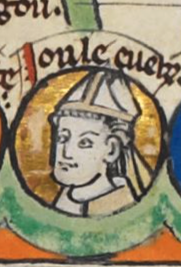
Hugh of Eu(Hugues, Hugo) was Bishop of Lisieux from 1049 to 1077.













